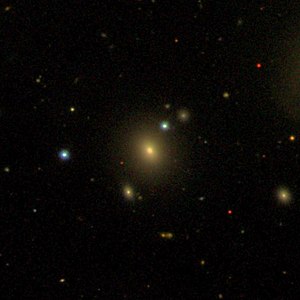IC 709
| Galaxy IC 709 |
|
|---|---|

|
|
| SDSS recording | |
| AladinLite | |
| Constellation | Big Bear |
|
Position equinox : J2000.0 , epoch : J2000.0 |
|
| Right ascension | 11 h 34 m 14.5 s |
| declination | + 49 ° 02 ′ 35 ″ |
| Appearance | |
| Morphological type | E2? |
| Brightness (visual) | 14.0 mag |
| Brightness (B-band) | 15.0 mag |
| Angular expansion | 0.60 × 0.6 |
| Surface brightness | 13.0 mag / arcmin² |
| Physical data | |
| Affiliation |
Abell 1314 WBL 339-002 |
| Redshift | 0.031732 ± 0.000053 |
| Radial velocity | 9513 ± 16 km / s |
|
Stroke distance v rad / H 0 |
(427 ± 30) · 10 6 ly (131.0 ± 9.2) Mpc |
| history | |
| discovery | Lewis Swift |
| Discovery date | May 11, 1890 |
| Catalog names | |
| IC 709 • PGC 35736 • CGCG 242-049 • MCG + 08-21-057 • 2MASX J11341457 + 4902352 • GALEX ASC J113414.54 + 490236.5 • LDCE 818 NED002 | |
IC 709 is an elliptical galaxy of Hubble type E in the constellation Ursa Major. It is estimated to be 427 million light years from the Milky Way and about 75,000 light years in diameter .
The galaxies IC 708 , IC 711 , IC 712 are located in the same area of the sky .
The object was discovered by Lewis Swift on May 11, 1890 .
